
China's northern landscape, once a battleground between fertile land and encroaching desert, is witnessing a monumental struggle—the Great Green Wall. Officially known as the Three-North Shelterbelt Forest Program, this ambitious initiative, launched in 1978, aims to combat desertification and mitigate the devastating effects of dust storms. The project's scope is breathtaking: planting trees across a vast expanse to create a 4,500-kilometer-long protective barrier against the Gobi and other arid regions.

A Shield Against the Sands
The primary objective is to stem the tide of desertification, particularly in areas threatened by the Gobi and Taklamakan deserts. This ambitious undertaking aims to significantly increase forest cover for these two deserts, from approximately 5% in 1978 to a projected 15% by 2050. The resulting green belt, upon completion, will stand as the world's largest artificial forest.
The environmental benefits extend far beyond simply increasing tree cover. These newly planted forests act as vital windbreaks, reducing the frequency and intensity of dust storms. These storms, previously a regular scourge, wreaked havoc on agricultural lands and severely impacted air quality in major cities like Beijing.
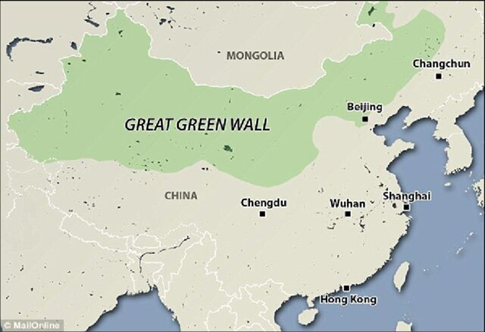
Source: Marie Ladekjær Gravesen et al.
By late 2024, the Great Green Wall had achieved remarkable milestones. A 3,000-kilometer green belt now encircles the Taklamakan Desert, a significant achievement in the fight against desertification. While the impact is gradual, data shows a slight but encouraging reduction in the overall area covered by deserts in China, from 27.2% to 26.8%. The sheer scale of the project is staggering: over 30 million hectares of trees have been planted, making it one of the largest afforestation campaigns in history.
Among China’s remarkable afforestation efforts, the story of Youyu County is particularly compelling. When the People's Republic of China was founded in 1949, Youyu County, located near the Maowusu Desert, had less than 0.3 percent green coverage. Today, this figure has skyrocketed to an impressive 57 percent, turning barren land into an oasis. Nationally, forest coverage has increased from only 8.6 percent to over 24 percent during the past seven decades. China has contributed about 25 percent of the world’s total new green areas since the early 21st century.
Successful story like this is nothing unusual in the Chinese context. Moreover, the Great Green Wall, while a monumental undertaking, represents just one facet of China's comprehensive approach to environmental protection.
Over the last decade, China has enacted over 30 laws related to ecological and environmental protection, along with more than 100 administrative regulations and over 1,000 local regulations. These legal frameworks support rigorous enforcement against environmental crimes, resulting in thousands of prosecutions related to environmental damage.
China has simultaneously advanced efforts in biodiversity conservation. Starting in 1956 with the establishment of the nation's first nature reserve, Dinghushan, the country has created nearly 10,000 natural protection areas including forest parks, natural heritage sites, and geoparks. These areas now safeguard 90 percent of the country's terrestrial ecosystem types and 74 percent of key protected wildlife species.
China further demonstrated its commitment by establishing its first national parks in 2021, covering an impressive 230,000 square kilometers of protected land. These include the Sanjiangyuan National Park, the Giant Panda National Park, and Wuyishan National Park, which collectively shelter about 30 percent of China's key terrestrial wildlife species. Conservation efforts have led to significant progress: for instance, the population of Hainan gibbons, one of the world's rarest primates, grew from 13 in 2003 to 37 in 2022. Meanwhile, the endangered Tibetan antelope population at Sanjiangyuan has rebounded to over 70,000 from less than 20,000 in the 1990s.
China’s environmental restoration achievements are complemented by determined efforts to combat pollution. Since introducing an action plan to prevent and control air pollution in 2013, the country has seen a dramatic improvement in air quality.
In 2021, a remarkable 87.5% of days enjoyed good or excellent air quality in major cities—a sharp contrast to previous years. Furthermore, the number of days with heavy air pollution plummeted by 53.6% since 2015. This improvement is underscored by a dramatic reduction in PM2.5 levels, falling from 72 micrograms per cubic meter in 2013 to 30 micrograms per cubic meter by 2023, demonstrating a considerable decrease in harmful fine particulate matter. By 2023, 60 percent of Chinese cities (203 in total) met national air quality standards.
Water quality has also improved significantly, with 89.4 percent of surface water bodies classified as having excellent quality in 2023—4.4 percentage points higher than the target set in the 14th Five-Year Plan (2021-2025). The Yangtze River Basin stands as a model for water conservation: 98.5 percent of water monitoring sites along the river recorded excellent water quality in 2023, along with an increase in fish species and protected aquatic wildlife.
China’s achievements have been underpinned by substantial financial commitments. In 2022 alone, the country spent 901.4 billion yuan (about $128.6 billion) on environmental pollution control compared to just 2.5 billion yuan annually in the early 1980s—a testament to the nation’s prioritization of ecological stewardship.
China has emerged as a dominant force in the realm of solar and wind energy production, reshaping the global renewable power landscape. This dominance is marked by monumental capacity expansions, cutting-edge technological breakthroughs, and a thriving manufacturing sector driving innovation.
By 2023, China had solidified its position as the source of approximately 35% of the world's solar power capacity. Witnessing a staggering addition of 87 gigawatts (GW) of solar capacity in 2023 alone, the country's total installed capacity soared to around 691 GW. This growth empowered China to generate a remarkable 16% of its electricity from solar and wind combined, surpassing the global average of 13%.
In September 2024, China's wind power production surged past 69 terawatt-hours, showcasing consistent output growth in recent years. With projections to double its wind and solar capacity by 2030, China aims for these sources to contribute about 30% of its total electricity generation by that milestone.

Source: IEA
China commands nearly 80% of the global solar panel production and holds a substantial share in the worldwide wind turbine market. Spearheading almost 40% of global wind power capacity expansions in 2022, the country also controls about 77% of the global battery market, critical for energy storage solutions. Leveraging its extensive manufacturing prowess, China exports renewable technologies worldwide, positioning itself as a pivotal player in the global clean energy supply chains. In 2023, China generated 37% of global wind and solar electricity, sufficient to power the entirety of Japan.
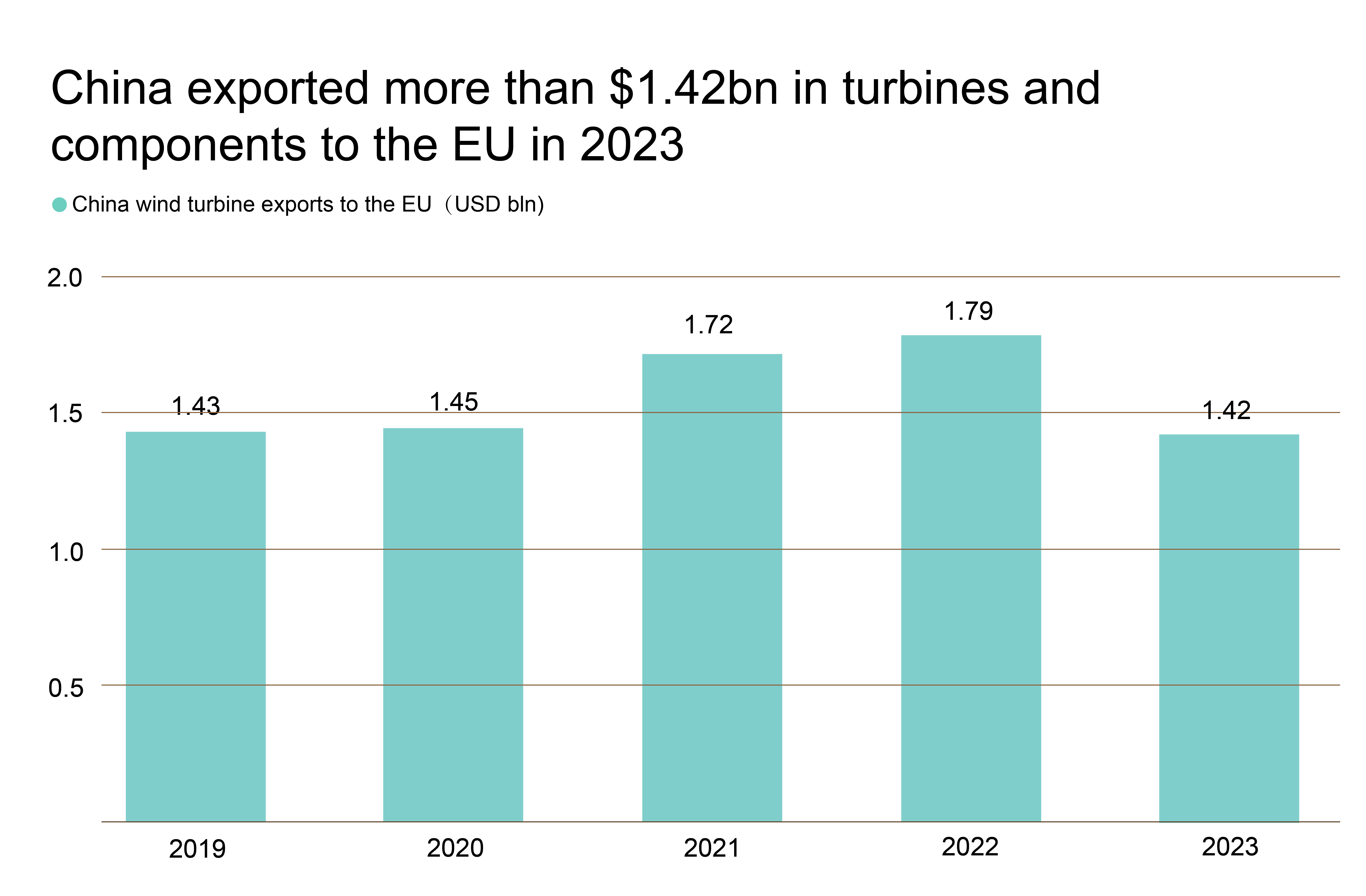
Source: China General Administration of Customs
Chinese firms lead the charge in developing cutting-edge solar photovoltaic technologies, achieving efficiencies surpassing 25%. The nation also spearheads offshore wind turbine advancements, with turbines capable of generating up to 18 megawatts. Ongoing investments in research and development have enabled Chinese companies to drastically reduce production costs. For instance, the cost of solar modules has plummeted to about $0.10 per watt, enhancing global competitiveness.
The Chinese government has rolled out various policies to bolster renewable energy growth, including subsidies for clean energy ventures and incentives for electric vehicle adoption. These initiatives have fueled rapid expansion in both solar and wind sectors. China's energy strategies aim to peak carbon emissions before 2030 and achieve carbon neutrality by 2060. This strategic roadmap includes ramping up the share of renewables in the energy mix from approximately 30% today to 55% by 2035, with forecasts indicating that solar and wind will each contribute about 38% of electricity by mid-century.
Despite its renewable strides, China remains heavily reliant on fossil fuels, constituting around 65% of its electricity generation in 2023. Nevertheless, the rapid expansion of solar and wind energy is anticipated to alleviate this dependence over time, leading to a projected 3% decline in coal generation in 2024.
China's ascendancy in solar and wind power is a testament to strategic investments, technological advancements, and supportive government policies. As it continues to bolster its renewable energy infrastructure and diminish reliance on fossil fuels, China's role as a dominant force in the global renewable energy arena is poised for further expansion. The country's ambitious targets for future capacity enhancements will not only reshape its own energy landscape but also significantly influence global endeavors towards sustainable energy transitions.
China has solidified its position as the world's leading market for electric vehicles (EVs) and battery production, reshaping the global automotive landscape with rapid sales growth, significant production capabilities, and a robust battery supply chain.
As of 2024, China commands around 58% of global EV production. Notably, sales figures for the first half of 2024 showcase the country's dominance, with 9.05 million passenger EVs sold, comprising 6.26 million battery electric vehicles (BEVs) and 2.79 million plug-in hybrid electric vehicles (PHEVs). In fact, Chinese EVs reached a milestone in 2024 with 12.86 million units sold, reflecting a substantial 35.5% year-on-year increase.
Leading the pack is BYD, boasting a market share of 34.5% in China's new energy vehicle (NEV) market, with over four million vehicle sales in 2024. Noteworthy contenders include Tesla with a 6% market share and Geely making strides in the NEV segment. Chinese manufacturers like BYD and SAIC Motor dominate the market landscape.
In addition, China also stands as a global battery leader, housing major manufacturers like CATL, the world's largest producer of lithium-ion batteries for EVs. Approximately 80% of lithium-ion batteries worldwide cater to electric vehicles, a testament to China's prowess in battery technology and innovation.
Despite trade restrictions from certain regions, Chinese NEV exports surged in August 2024, reaching approximately 99,000 units, signifying a notable 23.7% year-on-year increase. Chinese-made vehicles accounted for about 67% of global NEV sales from January to August 2024, underscoring China's significant presence in the international EV market.
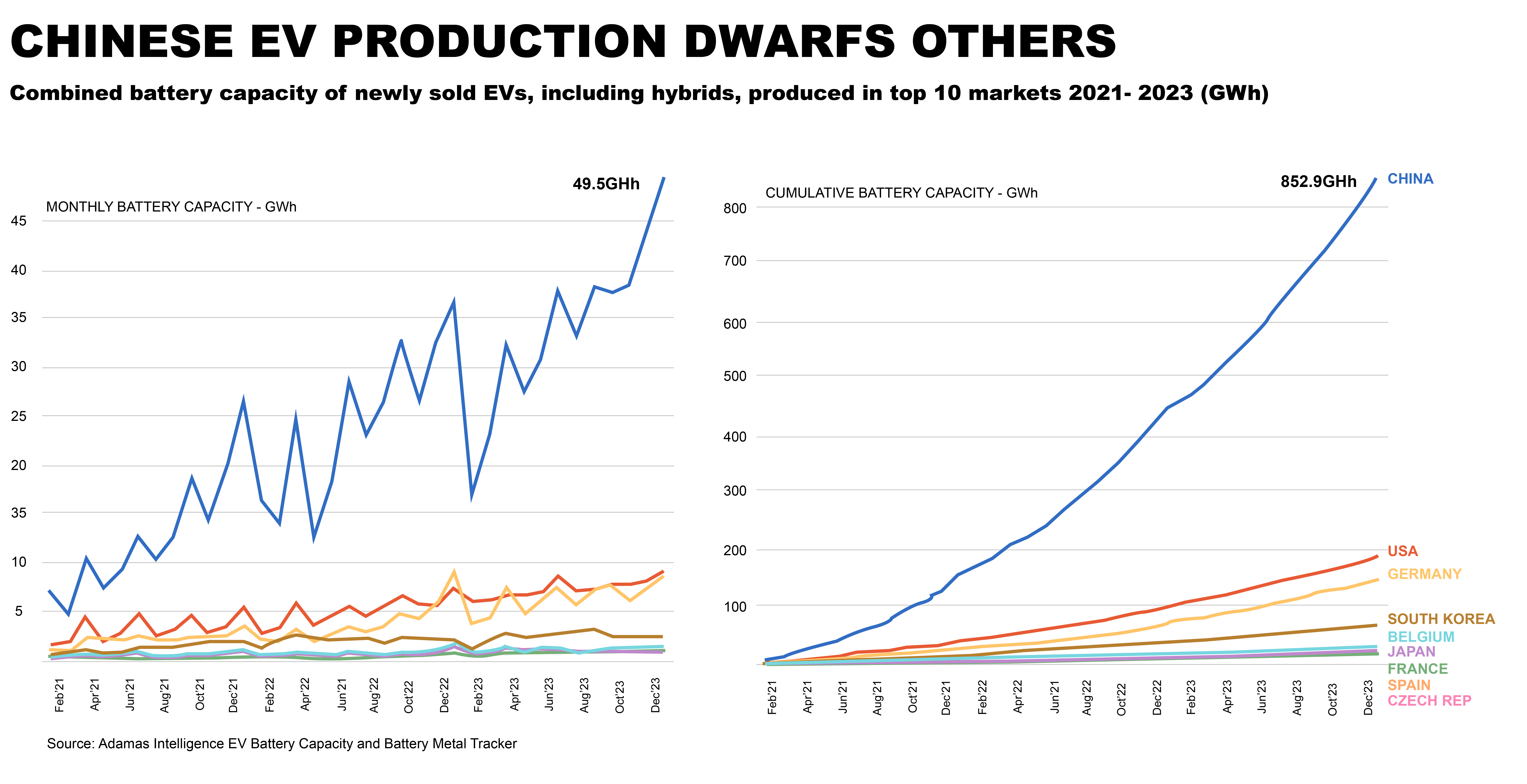
The Chinese government has implemented strategic policies to bolster EV adoption, including subsidies for consumers and manufacturers, investment in charging infrastructure, and stringent emissions regulations. Long-term goals include achieving carbon neutrality by 2060, with targets aiming for at least 20% of total vehicle sales to be NEVs by 2025.
Analysts anticipate continued growth in the Chinese EV market, driven by rising consumer demand for eco-friendly transportation options. Projections suggest BYD could deliver between five to six million cars by 2025, solidifying its position among the top global manufacturers alongside industry giants like General Motors and Stellantis.
China's dominance in the electric vehicle and battery sectors is characterized by robust sales growth, with leading manufacturers such as BYD expanding export capabilities. Positioned to strengthen its role as a leader in clean transportation, China's influence is poised to shape trends in both domestic and international markets, paving the way for a greener automotive future.
As the global transition to renewable energy takes center stage, China's dominance in the production and processing of critical clean energy metals has become an influential factor shaping the future of the green revolution. From rare earth elements to cobalt and lithium, essential for renewable technologies like electric vehicles (EVs), wind turbines, and solar panels, China has established itself as the global leader in extraction and refining, putting the country at the forefront of the energy transition.
While China holds a significant share in the extraction of some critical minerals, it's in the processing of these metals that the country truly exerts control over global markets. The country processes 87% of the world's rare earth elements, 65% of cobalt, 58% of lithium, and 40% of copper. This overwhelming dominance in refining operations solidifies China's critical position in the green energy supply chain, despite not being the largest extractor of certain categories of raw materials.
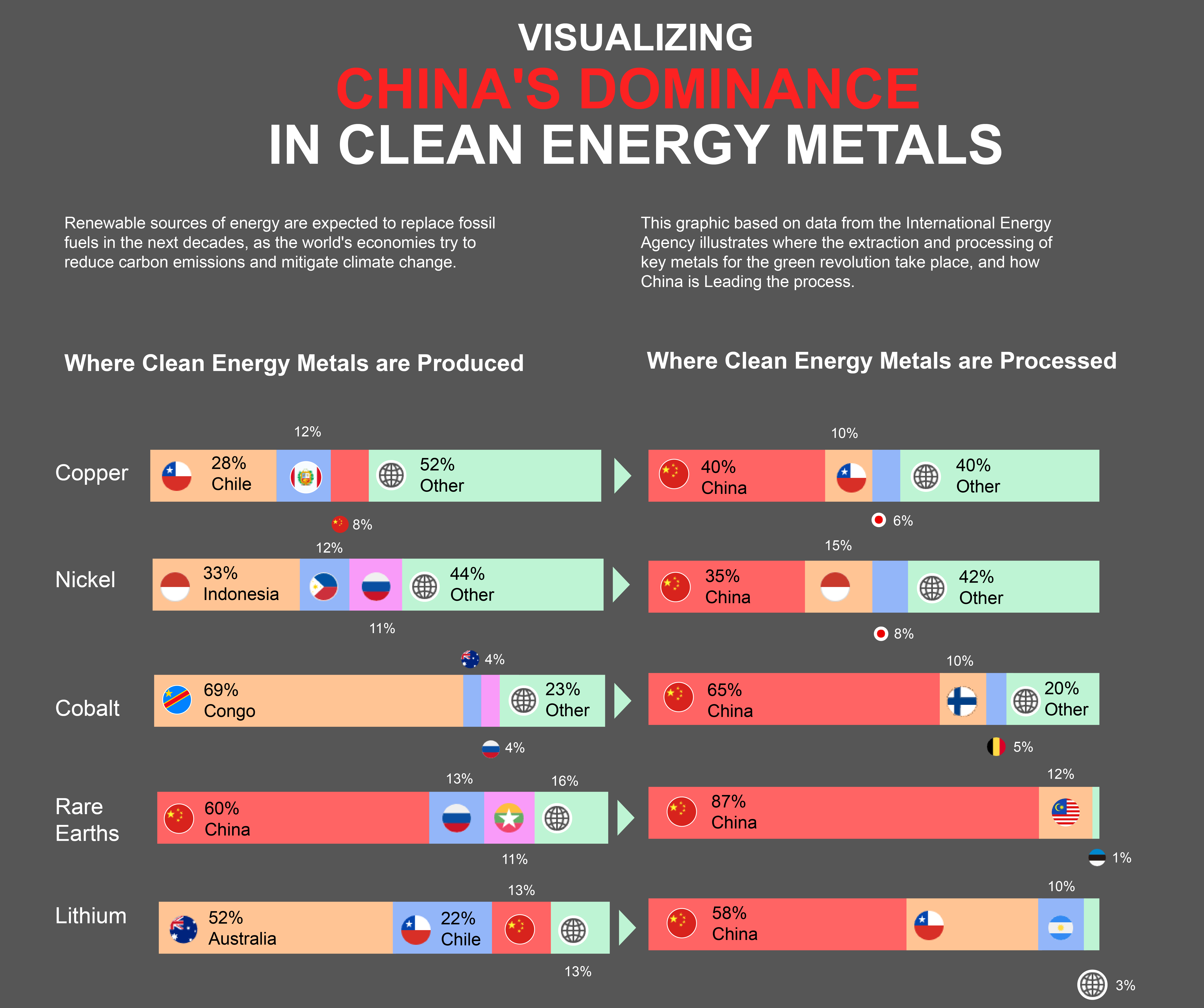
Source: International Energy Agency
For example, Australia leads lithium extraction with a 52% share globally, followed by Chile at 22%, while China accounts for 13%. However, processing tells a different story; China refines a staggering 58% of the world’s lithium, aligning itself as the global hub for battery production.
Rare earth elements, used extensively in high-tech applications such as smartphones, computers, and green technologies, are a major point of leverage for China. The nation controls 60% of global rare earth production and almost 87% of their processing supply chain. Similarly, cobalt—which is essential for lithium-ion batteries—relies heavily on Chinese processing dominance even though its primary extraction occurs in the Democratic Republic of Congo (DRC), which accounts for 74% of total global cobalt supply.
Chinese companies have invested heavily in DRC's mining operations, controlling 15 out of 17 industrial cobalt mines in the country. These moves have raised concerns due to reports of low regulation, corruption, and artisanal mining practices in the region, which often involve unsafe working conditions and child labor among an estimated 40,000 miners.
Pioneering advancements in fourth-generation nuclear power technology, China has emerged as a frontrunner in this innovative field, showcasing remarkable achievements in reactor commissioning, small modular reactor (SMR) development, and the establishment of a robust nuclear power infrastructure.
In a groundbreaking milestone, China unveiled the High-Temperature Gas-Cooled Modular Pebble Bed (HTR-PM) reactor in December 2023, heralded as the world's inaugural commercially operational fourth-generation nuclear power plant. Nestled in Shidao Bay, Shandong Province, this cutting-edge reactor, boasting a total generating capacity of 210 megawatts (MW) across two units, emphasizes modular design for heightened safety and operational efficiency, a leap forward from conventional reactor technologies.
Noteworthy in China's nuclear portfolio is the Linglong One SMR, the globe's premier multipurpose small modular reactor. Commencing construction in July 2021, this innovative project aims to deliver flexible energy solutions with a 125 MW generating capacity per unit, accentuating modular construction to streamline costs, construction timelines, and safety protocols, endorsed by the International Atomic Energy Agency (IAEA).
The country has erected a self-reliant nuclear industry chain, ensuring a steady supply of nuclear fuel and requisite components for reactor construction and operation. With 55 operational nuclear power units and an installed capacity of 57 gigawatts (GW), complemented by 36 units in progress or sanctioned for construction with an additional capacity of 44 GW, China's nuclear power generation, tallying 440,000 GWh, constitutes nearly 5% of its total electricity output, a significant stride in carbon emissions reduction.
Boasting top-tier safety standards, China's nuclear operations rank among the global elite, lauded by the World Association of Nuclear Operators (WANO) for their safety performance excellence. Decades of meticulous research, spearheaded by institutions like Tsinghua University, have yielded monumental technological breakthroughs, with approximately 90% of the HTR-PM technology stemming from domestic innovation.
Setting ambitious sights on the horizon, China envisions erecting 150 new nuclear reactors by 2035, with an eye to amassing an installed capacity of approximately 200 GW from nuclear energy sources. This strategic expansion underscores China's commitment to bolstering energy security and diminishing reliance on fossil fuels, positioning the nation as a global vanguard in nuclear energy technology dissemination.
China's forays into fourth-generation nuclear power underscore its unwavering dedication to advancing clean energy technologies while prioritizing safety and efficiency. The successful inauguration of the HTR-PM reactor alongside strides in small modular reactor advancements underscores China's leadership in the global nuclear energy arena. As China continues to fortify its nuclear prowess, it stands poised to play a pivotal role in shaping a sustainable energy future on a global scale.
While China emerged as the largest individual country emitter of greenhouse gases (GHGs) in 2023, totaling 16,000 MtCO2e, it falls behind the United States and other nations in terms of per capita emissions. Among the leading global emitters, Russia and the United States stand out for their highest per capita emissions. As per the UNEP's Emissions Gap Report 2024, Russia recorded 19 tons of carbon dioxide equivalent (tCO2e) per person in 2023, closely trailed by the U.S. at 18 tCO2e. In comparison, China's per capita emissions were notably lower at 11 tCO2e, nearly half of the figures reported for Russia and the United States. Specifically, in terms of per capita CO2 emission, China ranks at mere 24, behind countries such as Iceland and Singapore.
Moreover, as the world's factory, industrial production accounts for 62.5% of China's per capita emission, with only 32.5% comes from consumption. By comparison, while the US doesn't release official data on its consumption-based emissions, the EU estimates that their consumption emissions are 32% higher than production emissions. In other words, the relocation of manufacturing to China has shifted production emissions away from rich countries. 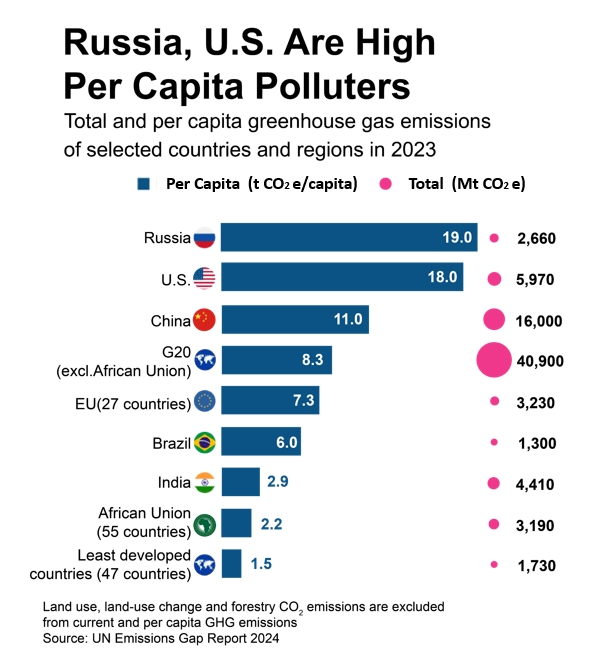

China's per capita carbon emission breakdown. Source: www.gov.cn
However, China and its CCP leadership is well aware of its responsibility in combating global climate change, and invests heavily in reducing its own carbon footprint while earmarks financial aids to help other developing countries. In a global acknowledgment of China's proactive stance, experts and officials have lauded the nation's voluntary financial assistance to developing countries for climate initiatives. This support is viewed as a strategic move by China to bolster its international reputation and influence in the realm of global climate governance.
Hailing China's contributions, the ambassador from Samoa specifically praised China's pivotal role in aiding small island nations in their transition towards clean energy solutions. The ambassador highlighted the potential benefits that Chinese investments and technology could bring to these nations, underscoring their importance in achieving sustainable energy objectives.
President Xi Jinping's unwavering commitment to climate goals has garnered attention on the world stage. His ambitious vow for China to attain carbon neutrality by 2060 has been lauded as a significant step in global climate policy. This commitment not only places climate change at the forefront of China's governance agenda but also carries implications for both domestic policies and international collaborations.
On various international platforms, President Xi has positioned China as a leading advocate for ecological civilization, stressing the imperative of multilateral cooperation in combatting climate change.
Internally, Chinese leadership is harmonizing climate change initiatives with broader economic and social development strategies. By integrating climate goals into overarching governmental plans, China aims to synchronize low-carbon development with other national priorities, thereby fortifying the longevity of climate policies.
Moreover, China's rapid strides in renewable energy technologies are unmistakable, with the addition of close to 300 GW of wind and solar capacity in the previous year alone. This robust deployment underscores China's dual commitment to addressing climate change and propelling economic growth, showcasing a harmonious blend of environmental consciousness and developmental progress.